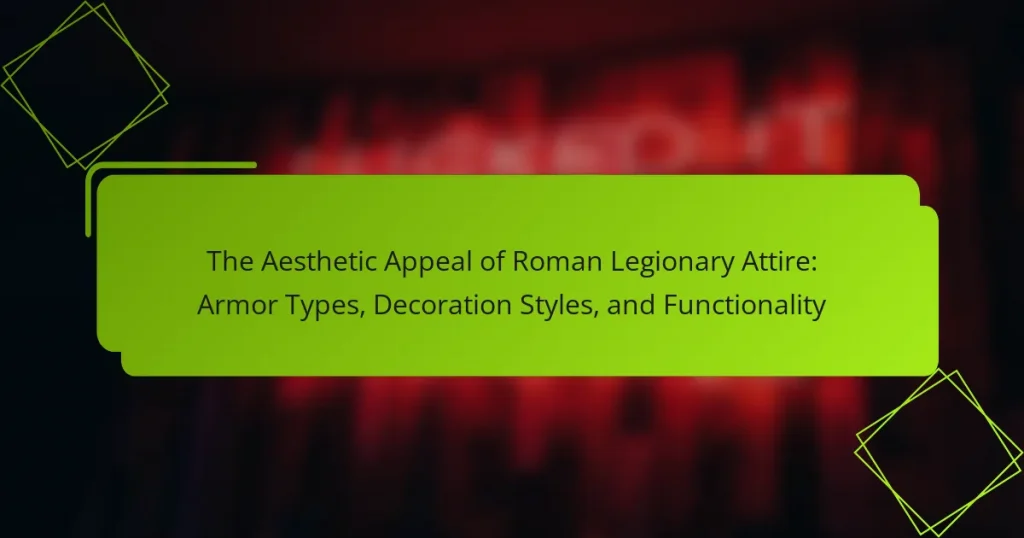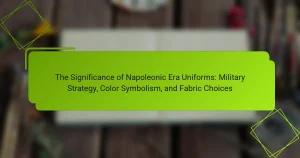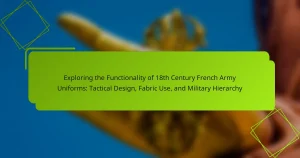The article focuses on Roman legionary attire, highlighting its aesthetic appeal through a blend of functionality and striking visual elements. Key components of this attire include various types of armor, such as the lorica segmentata, lorica hamata, and lorica squamata, each designed for protection and mobility. The article also examines decoration styles like intricate embroidery, color symbolism, and metal embellishments that signify rank and unit affiliation. Additionally, it discusses how the overall design reflects military discipline and effectiveness in battle, reinforcing the identity of the Roman legion.
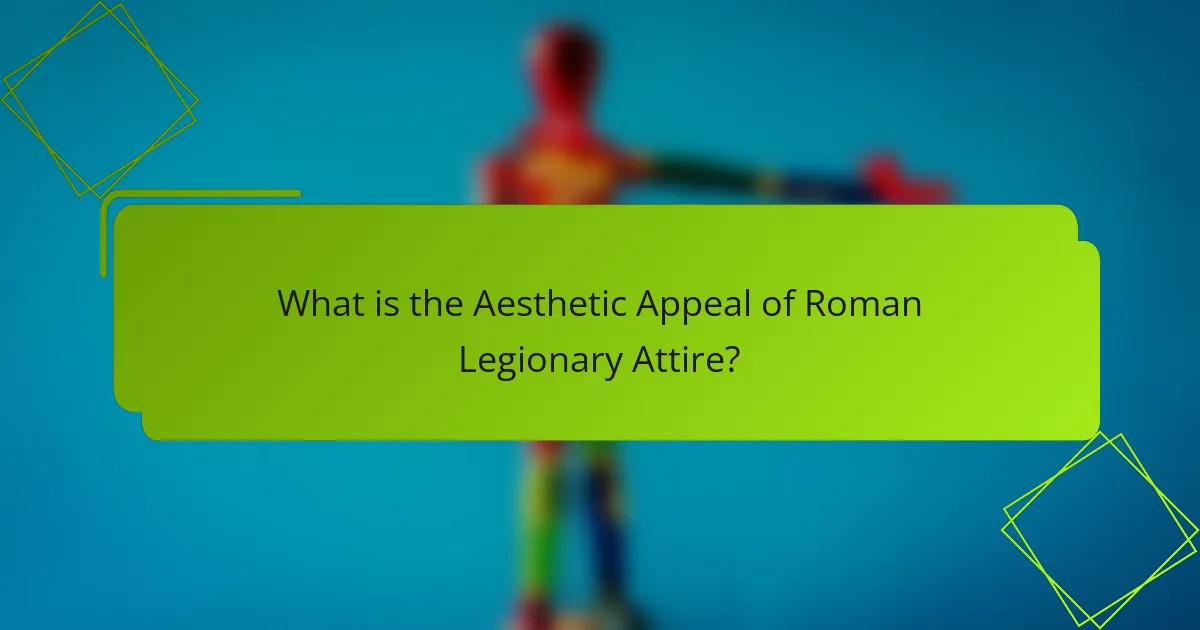
What is the Aesthetic Appeal of Roman Legionary Attire?
The aesthetic appeal of Roman legionary attire lies in its combination of functionality and striking visual elements. The armor features intricate designs and polished surfaces that reflect light, enhancing its visual impact. The use of red and brass accents creates a bold color contrast that is eye-catching. Additionally, the structured form of the armor conveys strength and discipline, embodying the military prowess of the Roman Empire. Historical records show that the attire was designed not only for protection but also to instill fear in enemies and pride in soldiers. The iconic helmet, with its distinctive crest, further adds to the overall grandeur and recognition of the legionary’s appearance.
How did Roman legionary attire evolve over time?
Roman legionary attire evolved significantly from the early Republic to the late Empire. Initially, legionaries wore simple tunics and basic armor. By the late Republic, they adopted the lorica hamata, a chainmail armor that offered better protection. The introduction of the lorica segmentata in the 1st century AD marked a major advancement. This segmented armor provided enhanced mobility and defense. Additionally, the helmets evolved from simple designs to more complex forms with face guards. Decorative elements, such as plumes and crests, became more prominent in the Empire. Overall, these changes reflected advancements in military tactics and technology. The evolution of attire was crucial for the effectiveness of Roman legions in various combat scenarios.
What historical influences shaped the design of legionary armor?
The design of legionary armor was shaped by various historical influences. The primary influence was the need for protection and mobility in battle. Roman military encounters with other cultures introduced new armor styles. For instance, the influence of Greek hoplite armor is evident in the design of the lorica segmentata. Additionally, the Celts contributed to the adoption of chainmail techniques. The integration of these styles improved overall functionality and effectiveness in combat. Historical records indicate that armor evolved to meet the changing demands of warfare. The adaptation of armor types reflected the Roman military’s strategic priorities throughout different periods.
How did the aesthetic choices reflect Roman values?
Aesthetic choices in Roman legionary attire reflected values of discipline, strength, and unity. The design of armor emphasized functionality and protection, showcasing the Roman commitment to military efficiency. Decorations, such as intricate patterns and symbols, communicated rank and achievements, reinforcing the importance of honor and status. The use of standardized styles promoted a sense of belonging among soldiers, highlighting the value of collective identity. Additionally, the grandeur of ceremonial attire illustrated the power of the Roman state, aligning military success with national pride. Overall, these choices reinforced core Roman ideals through visual representation.
What are the key components of Roman legionary attire?
The key components of Roman legionary attire include the helmet, armor, tunic, and sandals. The helmet, known as a galea, provided head protection and often featured decorative crests. The armor, primarily the lorica segmentata, consisted of metal strips for protection and mobility. Legionaries wore a tunic underneath their armor, typically made of wool. The tunic was knee-length and served as a base layer. Sandals, or caligae, were sturdy footwear designed for long marches. Additionally, a belt, called a cingulum, held the sword and provided support. Each component was essential for the functionality and effectiveness of the legionary in battle.
What types of armor were commonly used by Roman legionaries?
Roman legionaries commonly used several types of armor. The primary armor was the lorica segmentata. This armor consisted of metal strips and provided excellent protection while allowing mobility. Legionaries also wore a chainmail called lorica hamata. This type offered flexibility and was effective against slashing attacks. Additionally, some legionaries utilized the lorica squamata, which featured scales attached to a fabric backing. This design provided both protection and a distinctive appearance. The use of these armors was crucial for the effectiveness and survival of Roman soldiers in battle.
How did the materials used affect the appearance and functionality of the armor?
The materials used in Roman armor significantly influenced both its appearance and functionality. Steel and iron provided durability and protection against weapons. This choice of metal resulted in a shiny, polished look, enhancing the armor’s aesthetic appeal. Leather was often used for straps and padding, contributing to comfort and flexibility. The use of bronze for decorative elements added visual interest and indicated rank or status. Moreover, the combination of materials allowed for a balance between weight and protection. For example, chainmail provided mobility while still offering defense. Overall, the materials selected directly impacted how the armor looked and how effectively it served its purpose in battle.
Why is the aesthetic appeal of Roman legionary attire significant?
The aesthetic appeal of Roman legionary attire is significant because it reflects the power and discipline of the Roman military. Roman soldiers wore uniforms that were designed to be both functional and visually striking. The use of bright colors and intricate designs conveyed a sense of authority and pride. Additionally, the standardized attire fostered unity among soldiers, enhancing their collective identity. Historical records indicate that the visual impact of legionary attire played a role in psychological warfare, intimidating enemies. The combination of armor and decoration also showcased the technological advancements of the time. These elements contributed to the overall effectiveness of the Roman military in both combat and recruitment.
How does the visual design contribute to the perception of power and authority?
Visual design significantly contributes to the perception of power and authority by utilizing specific elements like color, shape, and ornamentation. In Roman legionary attire, the use of bold colors such as red and gold symbolizes strength and valor. The armor’s imposing shapes and structured forms project a sense of stability and dominance. Ornate decorations, like intricate engravings, enhance the visual impact, signifying rank and prestige. Historical examples show that Roman generals wore more elaborate designs to differentiate themselves from regular soldiers. This hierarchy in design visually reinforces authority within military ranks. The combination of these elements creates an immediate impression of power, influencing how individuals perceive authority figures.
What role did decoration play in differentiating ranks within the legion?
Decoration served a crucial role in differentiating ranks within the Roman legion. Specific adornments indicated the status and authority of soldiers. Higher-ranking officials wore more elaborate decorations, such as plumes or intricate metalwork. These visual cues helped in quickly identifying command structures on the battlefield. For instance, centurions often had distinctive helmets and insignia. This differentiation was essential for maintaining order during combat. Additionally, decorations conveyed a sense of pride and honor associated with rank. The use of decoration thus reinforced both hierarchy and morale within the legion.
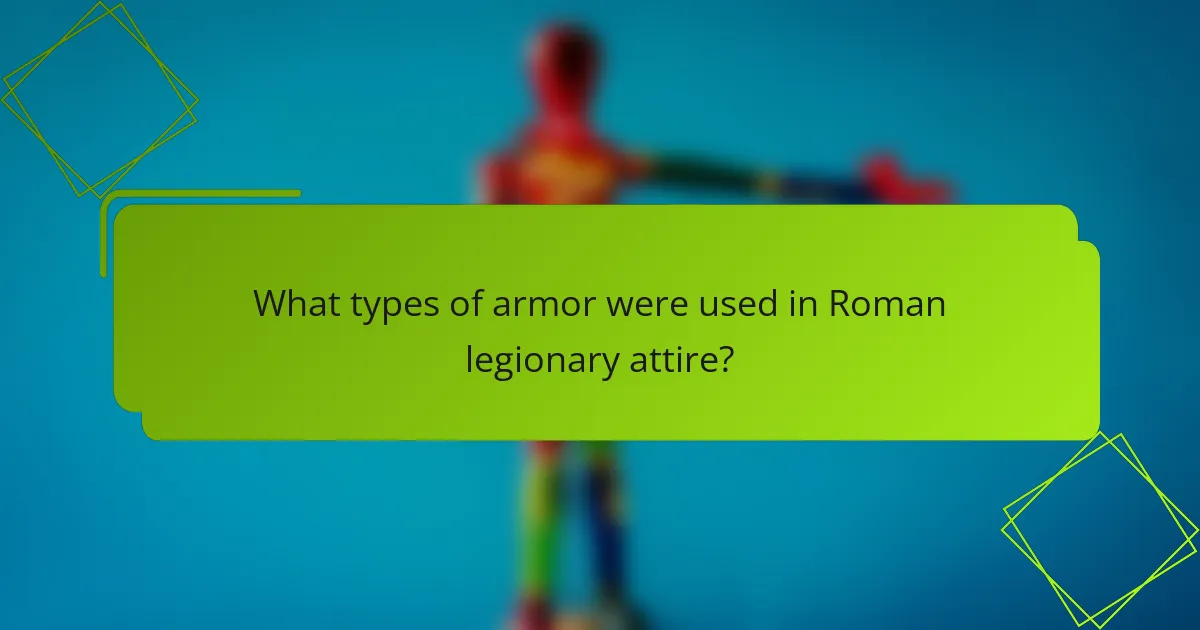
What types of armor were used in Roman legionary attire?
Roman legionary attire included several types of armor. The primary armor was the lorica segmentata. This armor consisted of metal strips that provided flexibility and protection. Legionaries also wore a chainmail shirt known as lorica hamata. This type offered good defense against slashing attacks. Additionally, they used the lorica squamata, which was made of small metal scales. Helmets, such as the galea, were also essential for protection. Shields, specifically the scutum, complemented the armor by providing additional defense. These armor types were crucial for the effectiveness of Roman soldiers in battle.
What are the primary types of Roman armor?
The primary types of Roman armor include the lorica segmentata, lorica hamata, and lorica squamata. The lorica segmentata is a type of plate armor made of metal strips, providing excellent protection and flexibility. The lorica hamata consists of chain mail, offering good defense while allowing mobility. The lorica squamata features scales attached to a fabric or leather backing, combining flexibility with solid protection. Each type was designed for different combat scenarios and soldier roles in the Roman army. Historical evidence from archaeological finds supports the existence and use of these armor types in various military campaigns.
How did the lorica segmentata differ from other armor types?
The lorica segmentata differed from other armor types primarily in its construction and flexibility. It consisted of metal strips or plates that were articulated, allowing for greater mobility. This design enabled soldiers to move more freely compared to solid armor types, like chainmail. The lorica segmentata also provided superior protection against slashing attacks. Its segmented structure allowed for better ventilation, reducing overheating during combat. Historical evidence shows that this armor was widely used by Roman legions from the 1st to 3rd centuries AD. The combination of protection and mobility made it a preferred choice among Roman soldiers.
What were the advantages of using chainmail in battle?
Chainmail provided significant advantages in battle. It offered flexible protection against slashing attacks. The interlinked rings distributed the force of blows effectively. This reduced the risk of deep cuts and punctures. Chainmail was lighter than solid plate armor. Soldiers could move more freely and quickly while wearing it. Additionally, it allowed for better ventilation compared to heavier armor types. Historical records show that chainmail was commonly used by Roman soldiers for these reasons. It combined practicality with a degree of aesthetic appeal in military attire.
How did armor types vary across different regions of the Roman Empire?
Armor types varied significantly across different regions of the Roman Empire. Regional adaptations were influenced by local materials, climate, and combat styles. In Italy, heavy lorica segmentata was common, providing excellent protection. In the provinces, lighter armor like chainmail was favored for mobility. The Gauls incorporated unique designs, reflecting their own cultural influences. In the Eastern provinces, armor often featured ornate decorations, showcasing local artistry. The desert regions utilized lighter, breathable materials suited for hot climates. Each region’s armor type served specific tactical needs and reflected the diverse cultures within the Empire. This variation highlights the adaptability of Roman military equipment to various environments and combat scenarios.
What unique features did local styles introduce to Roman armor?
Local styles introduced distinctive features to Roman armor, enhancing its functionality and aesthetics. Regional influences led to variations in helmet designs, such as the use of crests and decorative motifs. For instance, Gaulish helmets often featured elaborate decorations and unique shapes. Additionally, local materials influenced armor construction, with some regions using leather or different metals. The incorporation of local combat techniques also shaped armor design, providing better protection suited to specific warfare styles. These adaptations reflect the integration of local cultures into Roman military practices, illustrating the dynamic nature of Roman armor evolution.
How did climate influence the choice of armor materials?
Climate significantly influenced the choice of armor materials in ancient Rome. Different climates necessitated varying armor characteristics for protection and functionality. In warmer regions, lighter materials like linen or leather were preferred to enhance mobility and comfort. Conversely, in cooler climates, heavier materials such as metal were used to provide better insulation against the cold. Historical evidence shows that Roman legions adapted their armor based on the local environment. For instance, soldiers stationed in northern territories often wore layered armor for warmth. This adaptability ensured that the armor served both protective and practical purposes based on climatic conditions.
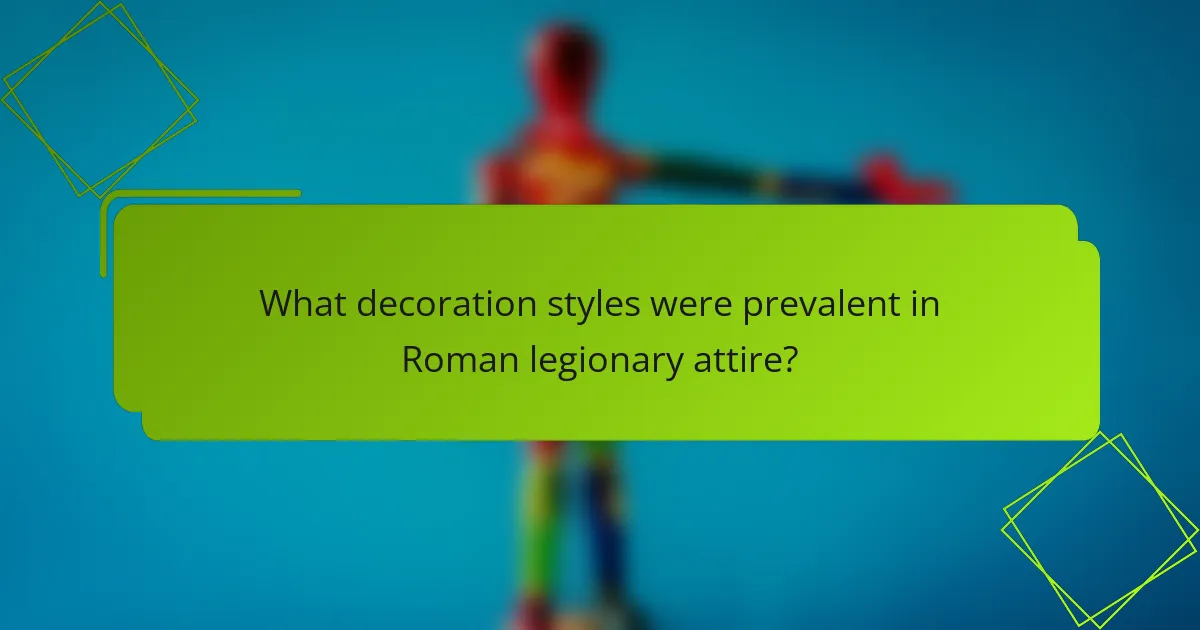
What decoration styles were prevalent in Roman legionary attire?
Roman legionary attire featured several prevalent decoration styles. These styles included intricate embroidery and appliqué designs. Legionaries often wore tunics adorned with stripes or borders. The colors used were typically red, blue, or white, signifying rank and unit. Additionally, metal embellishments such as brooches and fibulae were common. Shields were often painted with symbols or motifs representing the legion. Helmets could also feature decorative plumes or crests. These decorative elements served both aesthetic and functional purposes in battle.
What types of decorative elements were commonly used?
Common decorative elements used in Roman legionary attire included intricate metalwork, painted designs, and embroidery. Metalwork often featured bronze or silver embellishments on armor and helmets. These embellishments served both aesthetic and practical purposes, enhancing the visual appeal while providing protection. Painted designs were frequently applied to shields, showcasing symbols and patterns representing legions. Embroidery was used on tunics and cloaks, adding color and texture. These decorative elements reflected the status and identity of legionaries. Historical artifacts, such as preserved armor and shields, support the existence of these decorative styles in Roman military attire.
How did engravings and motifs reflect the identity of the legion?
Engravings and motifs reflected the identity of the legion by showcasing their values and achievements. Each engraving often depicted symbols of power, loyalty, or victory. For example, the eagle was a common motif representing strength and the divine protection of the gods. Additionally, unit insignias featured unique designs that distinguished one legion from another. These designs fostered a sense of belonging among legionnaires. The motifs also conveyed historical narratives, celebrating significant battles or victories. Furthermore, engravings on armor and shields served to intimidate opponents. They were an integral part of the legion’s visual identity in both battle and ceremonial contexts.
What materials were used for embellishments on armor?
Embellishments on armor were made from various materials including metal, leather, fabric, and gemstones. Metal was commonly used for decorative plates and fittings. Leather often served as a base for decorative elements and straps. Fabric was utilized for banners and linings, enhancing visual appeal. Gemstones were sometimes inlaid into armor for added ornamentation. Historical evidence shows that these materials were chosen for both aesthetic and functional purposes. The combination of these materials contributed to the overall splendor of Roman legionary attire.
How did decoration styles vary among different ranks?
Decoration styles among different ranks in the Roman legions varied significantly. Higher-ranking officers, such as centurions, wore armor decorated with intricate designs and embellishments. These decorations often included decorative insignia, plumes, and more elaborate patterns. In contrast, lower-ranking soldiers, like legionaries, had simpler designs with minimal ornamentation. Their armor focused on functionality rather than aesthetics. The differences reflected the hierarchy and status within the military. Historical records indicate that centurions’ armor could feature gold or silver accents, while common soldiers typically wore plain, utilitarian gear. This distinction in decoration styles helped to visually signify rank and authority within the legion.
What specific insignia were used to denote rank and achievements?
Roman legionaries used specific insignia to denote rank and achievements. These included various types of decorative elements on their armor and uniforms. For example, the insignia of a centurion featured a transverse crest on the helmet. This crest was often made of horsehair or feathers, distinguishing them from lower ranks. Additionally, ranks were indicated by different types of belts and badges, such as the phalerae. Phalerae were metal discs awarded for bravery and service. Other insignia included the use of colored tunics and specific types of cloaks. Each insignia served to visually communicate the soldier’s status and accomplishments within the legion.
How did the use of color and design signify status within the legion?
The use of color and design signified status within the Roman legion through specific visual markers. High-ranking officers wore distinct colors, such as crimson and purple, to denote their elevated position. These colors were often reserved for the elite, establishing a clear hierarchy. Additionally, intricate designs and embellishments on armor indicated wealth and rank. For example, centurions displayed unique insignia and decorative elements on their helmets and shields. The presence of these visual attributes created immediate recognition among soldiers and civilians alike. Thus, color and design served not only as aesthetic choices but also as powerful symbols of authority and status within the legion.

How did functionality influence the aesthetic of Roman legionary attire?
Functionality significantly influenced the aesthetic of Roman legionary attire. The design prioritized practical elements for combat effectiveness. Legionaries wore tunics that allowed for ease of movement. Armor was crafted to protect while maintaining mobility. The iconic lorica segmentata provided both defense and a distinctive look. Helmets were designed to offer protection without obstructing vision. Footwear was functional, designed for long marches and stability. The overall aesthetic reflected discipline and military prowess, reinforcing the legion’s identity. Historical accounts show that attire also conveyed rank and unit affiliation, enhancing the visual hierarchy within the legion.
What practical considerations shaped the design of armor?
The design of armor was shaped by several practical considerations. Protection against weapons was the primary factor. Armor needed to withstand swords, arrows, and other combat tools. Weight distribution was also crucial for mobility. Heavier armor could hinder movement, so designs aimed to balance protection and agility. Materials used were selected for durability and availability. Iron and leather were common choices due to their strength. Ventilation was necessary to prevent overheating during battles. Designs often included openings or lighter materials in less vulnerable areas. Cost-effectiveness influenced armor design as well. Armies required affordable solutions to equip large numbers of soldiers. These considerations collectively ensured armor was functional and effective in combat.
How did the need for mobility affect armor aesthetics?
The need for mobility significantly influenced armor aesthetics. Roman armor, such as the lorica segmentata, was designed to allow freedom of movement. This design minimized bulk and weight while maximizing protection. The aesthetic appeal was thus shaped by functional requirements. Streamlined shapes and lighter materials became common to enhance agility. Decorations were often kept minimal to avoid hindrance. Historical evidence shows that effective mobility was prioritized in battlefield scenarios. Consequently, armor aesthetics evolved to reflect a balance between protection and maneuverability.
What balance was struck between protection and visual appeal?
Roman legionary attire achieved a balance between protection and visual appeal through functional design and decorative elements. The armor was crafted to provide maximum defense while also displaying the status of the wearer. Materials such as iron and bronze offered durability and safety in battle. At the same time, intricate designs and embellishments were used to enhance the visual attractiveness of the armor. For instance, the use of polished metal surfaces reflected light, creating a striking appearance. Additionally, decorative motifs often signified rank and unit affiliation, merging aesthetics with military identity. This combination ensured that the armor was not only practical but also a symbol of pride and honor for the legionaries.
How did the functionality of armor impact its decorative aspects?
The functionality of armor significantly influenced its decorative aspects. Armor was primarily designed for protection and combat efficiency. However, as armor evolved, decorative elements became more prominent. The addition of intricate designs and embellishments often indicated rank and status. For example, commanders wore more ornate armor to distinguish themselves. Additionally, decorative features like engravings or color accents did not compromise functionality. Historical records show that Roman armor, such as the lorica segmentata, combined practicality with aesthetic appeal. This dual purpose enhanced the overall presentation of the legionaries while maintaining their protective capabilities.
What features were designed to enhance both protection and aesthetics?
Roman legionary attire incorporated features that enhanced both protection and aesthetics. These features included intricate designs on armor, such as embossed patterns and engravings. Such decorations not only served to intimidate opponents but also showcased the craftsmanship of the legionaries. Additionally, the use of polished metal provided a reflective quality, adding to the visual appeal. The layered structure of the armor offered enhanced protection while allowing for mobility. Furthermore, the inclusion of colorful fabrics and plumes on helmets contributed to the overall aesthetic, making the legionaries visually striking. Historical records indicate that these design elements were integral to Roman military strategy and identity.
How did the practical use of armor influence the choice of colors and materials?
The practical use of armor significantly influenced the choice of colors and materials. Armor needed to be durable and effective in combat. This led to the use of metals like iron and bronze for strength. The choice of colors was often dictated by the availability of dyes and materials. Bright colors indicated rank or unit affiliation, while muted tones provided camouflage. Additionally, materials like leather were used for flexibility and lightweight protection. Historical records show that Roman legions favored specific colors to denote their identity. The combination of functionality and visual representation shaped the overall design of armor.
What tips can enhance the appreciation of Roman legionary attire?
To enhance the appreciation of Roman legionary attire, study its historical context. Understanding the role of legionaries in the Roman Empire adds depth to their attire. Examine the materials used, such as iron and leather, which reflect the technology of the time. Analyze the armor types like the lorica segmentata, known for its effectiveness in battle. Observe the decorative elements, which signify rank and unit affiliation. Recognize the functional aspects of attire, designed for both protection and mobility. Visit museums or historical reenactments to see authentic replicas. Engaging with experts or reading scholarly articles can provide further insights into the significance of these garments.
The main entity of the article is Roman legionary attire, which encompasses various armor types, decoration styles, and functionality. The article explores the aesthetic appeal of this attire, highlighting how its design combines both visual impact and practical protection. Key components such as the lorica segmentata and decorative elements like insignia and colors are examined, revealing their significance in conveying rank and military identity. Additionally, the evolution of armor and its adaptation to different regions and climates are discussed, illustrating the interplay between functionality and aesthetics in Roman military attire.
